Day 1 - Board evening train from Hanoi to Lao Cai
I took the Livitrans train which left Hanoi at around 8.30PM. The railway station is unnecessarily chaotic for foreigners and locals alike - but it seems to work out in the end. The train was clean and comfortable - especially for the price. My travelling companions for the ride in my four berth sleeper were a baby that was unwell and his mother and grandma - so it was probably a little more noisy than most cabins. I still managed to get a good sleep in during the eight or so hours of the journey.
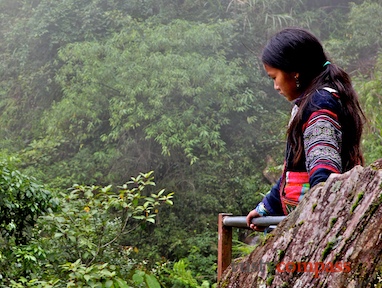
Photo: Mark BowyerBlack Hmong girl Sapa
Train arrived in Lao Cai at around 5.30AM. I had previously decided to take the long road to Sapa with plenty of stops along the way. Passed through some beautiful scenery as well as some great activity in the terraced rice fields and the small villages. The normal drive to Sapa takes about an hour. This route took about six hours with around 2.5 hours of stops and 3.5 hours of driving.
Was very happy I travelled this way but the long route is definitely for those with plenty of time. It would be possible to cut an hour or more out of the driving by avoiding some diversions from the main route to villages. The long route is more worthwhile during the wet season I'd suggest as the activity in the rice fields and the views are highlights. Visibility and activity would be much reduced in winter. It's worth trying to time your arrival to coincide with the Muong Hum market on Sundays.
In Sapa I did the walk to Cat Cat walk in the late afternoon - stunning conditions. A beautiful walk capped off a great day. Although Cat Cat attracts loads of tourists, it's still beautiful. Try doing the walk early or late in the day and avoid the crowds. You only need a couple of hours - especially if you come back by motorbike taxi or xe om.
Day 3 - Village walks around Sapa - Ta Van and surrounds. PM Ta Phin and surrounds.
Sapa was hit by heavy rain so I didn't have as full a day of exploration as I'd hoped. Spent the morning wandering around the town and its central market. We headed out in the afternoon and did some walks through Black Hmong villages and then on to Ta Phin, a Red Dzao village very popular with tour groups. Fortunately the rain kept the groups away so we had a nice visit.
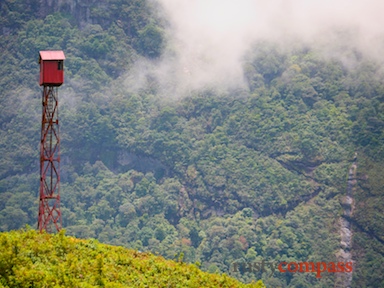
Photo: Mark BowyerFire lookout outside of Sapa
This is probably Vietnam's most stunning drive. We started with the short ride out of Sapa to Thach Bac falls. The falls are worth a visit only because they're en route to Paso. They are completely overrun by tourists and while beautiful in themselves, they don't come close to the beauty of this day of travel. They are a sobering display of eco tourism Vietnam style and they are the stop of choice for travellers to Sapa with no interest in any of the beautiful walks or the cultural richness of the area.
We left Thach Bac for the short drive on to Vietnam's highest mountain pass, Tram Ton Pass. The scenery here is spectacular - in part on account of the elevation and in part on account of the climatic clash that occurs here as the cool air of Sapa collides with the warm air of the Lai Chau region. The mist comes and goes and temperatures fluctuate wildly. In the wet season, the pass crossing will likely usher in very hot conditions as it did on this day.
The rest of the day to Paso consisted of regular stops at villages including those around Binh Lu. I also jumped out of the car many times and walked down to villages or along the road to absorb the glorious scenery. It took us 10 hours to do the 100 km drive on account of our constant stops. Without stops, the journey could be done in three hours.
Had a great simple lunch along the way near Binh Lu.
Day 5 - Sapa to Dien Bien Phu.
This is a 180km drive but we managed to set a much faster pace than we had the previous day. The scenery here is less spectacular as major roadworks are causing massive landslides and erosion - not pretty. The afternoon ride from old Lai Chau town to Dien Bien Phu was better and we stopped at some lovely Thai villages in the final 20 - 30 kms of the journey before reaching Dien Bien Phu in the late afternoon.
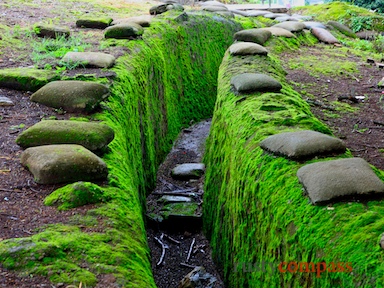
Photo: Mark BowyerDien Bien Phu - Trench at Hill A1, known to the French as Eliane 2
This day is best spent exploring the war history around the town in the morning before heading out into the countryside in the afternoon to Pa Khoang Lake and the bunker from which General Giap commanded Viet Minh forces. The countryside around Giap's bunker is beautiful as is the lake. The area is dotted with Thai minority villages.
History buffs will love Dien Bien Phu - and the remains of the battle are very evocative. These include A1 Hill, also known as Eliane 2, de Castries' bunker, the Muong Thanh bridge, the Dien Bien Phu Museum, the Viet Minh Cemetery and a simple memorial to French lives lost. In themselves these sites are not spectacular and they are poorly explained. A little bit of historical homework before arrival though will make for a very moving journey. Dien Bien Phu's setting in the Muong Thanh Valley is also beautiful.
Day 7 - Free time in Dien Bien Phu before transferring to the airport.
Hotels
There are plenty of options in Sapa. This trip I stayed at the Holiday Sapa Hotel - very comfortable and well located standard hotel. Room rates are around 30 - 40USD. If you want to pamper yourself in Sapa before you hit the more remote locales where standard and less are the only available accommodation styles, try the Victoria Sapa Hotel or the Chapa Garden Resort and Spa. In Paso and Dien Bien Phu, options are basic but comfortable. The Lan Anh in Pa So is the only show in town and the Dien Bien Hanoi Hotel is the best bet in Dien Bien Phu (also around 30USD per night).
Eating
Sapa has some very good and plain awful Vietnamese food. Didn't try western options and rarely do in remote parts. Best rule of thumb for Vietnamese food is to follow the Vietnamese. If it's a Vietnamese restaurant in Vietnam without Vietnamese customers, stay away. There is a strip of Vietnamese restaurants on Pham Xuan Huan St that cater mainly to Vietnamese tourists and these are the best options. Many of the tourist restaurants on the main drag are very mediocre. I had a very good meal at the Gerbera Restaurant and two ordinary meals at the Anh Dao. I gave the Anh Dao two chances because it was a favourite in the old days. As with so many restaurants in Vietnam, they brought in renovators, raised the prices and sacked the chef. Head to Pham Xuan Huan St for good simple Vietnamese cuisine. You may also like to try the Hmong menu at the Chapa Garden Hotel.
Transport
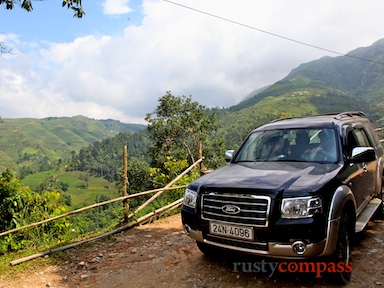
Photo: Mark BowyerGood quality transport is now available in Sapa for the rough roads
Weather
Weather is hard to call here - there are always advantages and disadvantages. I like the wet season because everything is green, fresh and lush and there is plenty of activity around the rice crops so it is the best time for photography - but the rain will slow you down occasionally and it can be very hot - especially outside Sapa. In winter, it's cold and misty and rice paddies are barren so the scenes are less appealing. March - April and August to October are favoured times but I am very happy I travelled in July this time.
Keep in mind....
The roads have improved markedly in recent years. The use of explosives however has destabilised the earth on many steep inclines resulting in frequent major landslides especially in the wet season. At best these can cause big delays and at worst they cause loss of life. For this reason, some companies advise against travelling between Sapa and Dien Bien Phu in the wet season.
If you want to visit places nearby Sapa such as Bac Ha and Can Cau markets, this could be added to this itinerary or an additional night could be added in Sapa or Bac Ha. This itinerary works well for those happy to walk 2 - 5 hours of reasonably easy walking per day - and you can really choose how much walking you want to do on the day. If you would like to do some more serious long treks, these could be included in this programme or additional days could be added.
Travel companies
A number of companies specialise in arranging travel to Vietnam's far north. I travelled with Topas Travel. My guide Mr Tan and my driver Mr Tuan were excellent. Mr Tan's interest and knowledge of ethnic minorities and some of their languages was a big bonus. They were helpful and flexible as I had requested.
Their knowledge of the area around Dien Bien Phu was noticeably less extensive than their knowledge of the rest of the journey - a problem that will have been addressed now after my visit. All up though, I was very pleased with Topas.
Handspan Travel in Hanoi has also been recommended. Details of the two companies are as follows:
Topas Travel
Email: sales@topastravel.vn
Address: 52 To Ngoc Van, Tay Ho, Hanoi
Tel : +84.4. 3715 1005 (ext. 114)
Web: www.topastravel.vn
Handspan Adventure Travel
Contact: Ms Thao
78 Ma May, Hanoi
Tel: +84 4 39262828 (ext 13)
Email: thaoco@handspan.com
Skype: handspan_thaoco
Web: www.handspan.com
Price guide
Topas Travel quoted $838US for a single traveller and $498US for a twin or double per person for the itinerary outlined above.
Handspan travel quoted $1072US for a single traveller and $587US for a twin or double per person.
These prices include train from Hanoi, all accommodation, guides, transport and other inclusions. For details contact the companies in Hanoi.
Rusty Compass editorial content and reviews are independent of commercial arrangements with hotels, restaurants, tour operators, airlines, national tourism bodies or other third parties. Rusty Compass accepts subsidised travel from suppliers when this is offered. We do not publish advertorial.

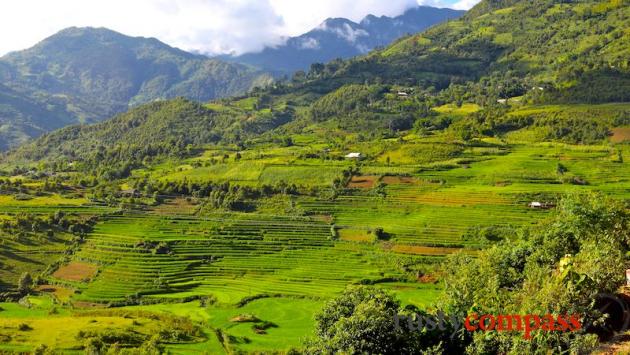



There are no comments yet.